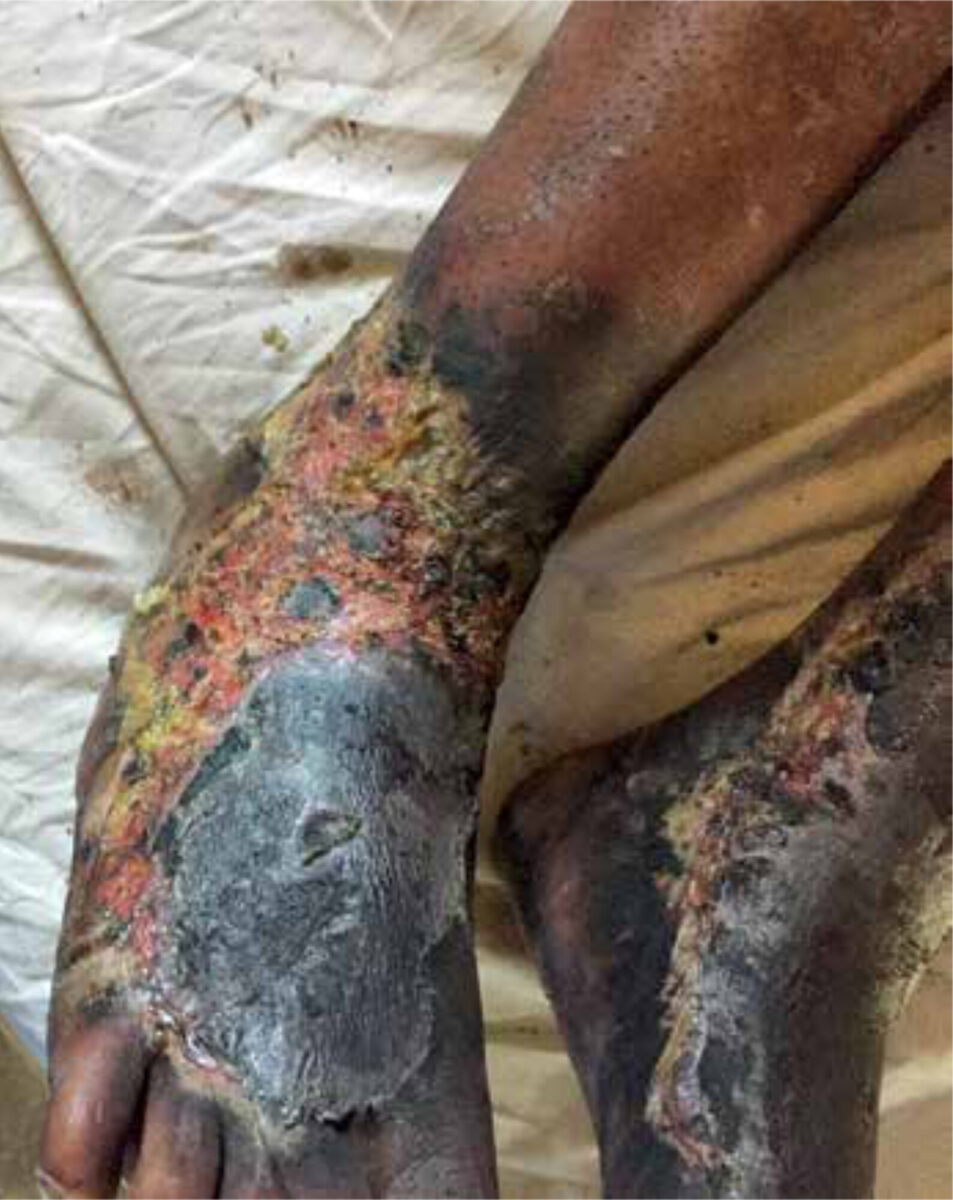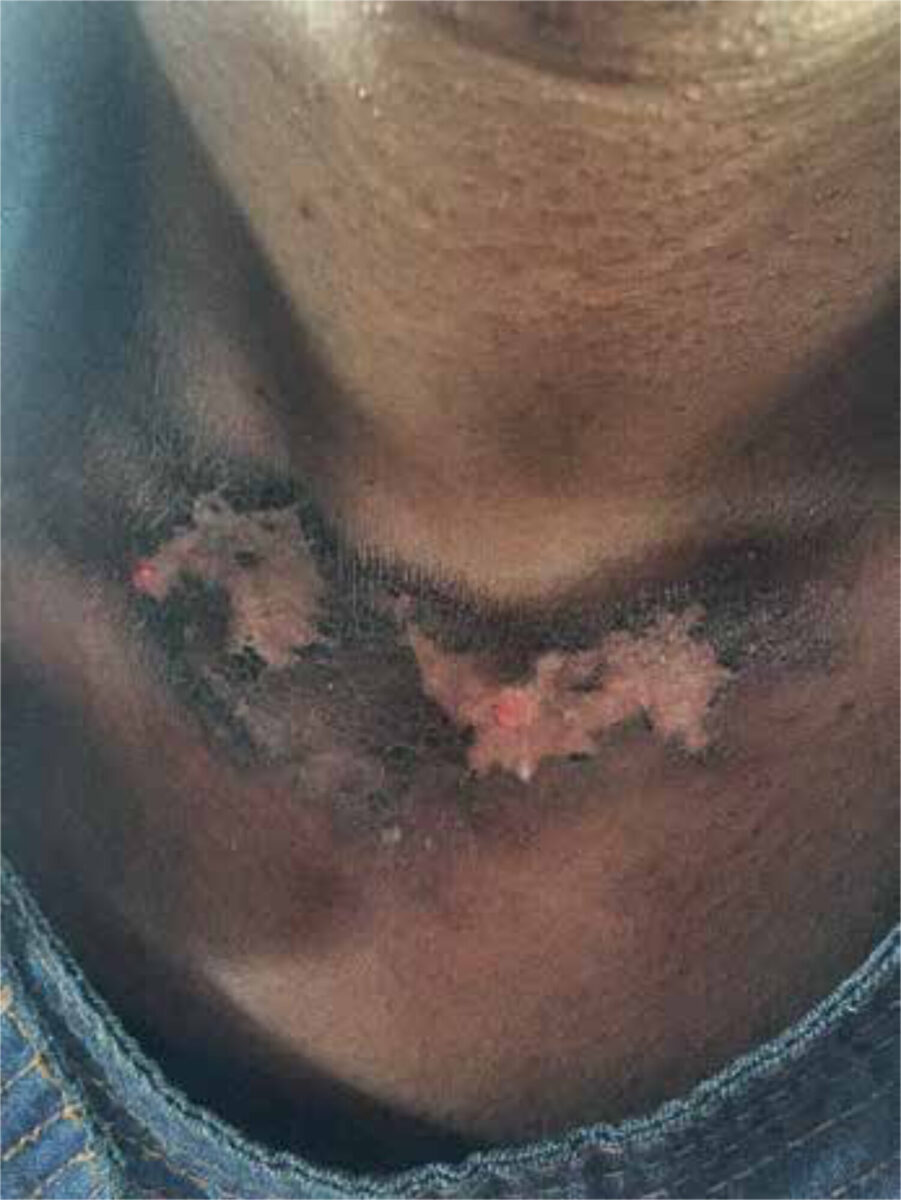Main content
| Consult Online is a digital consultation service, designed for medical doctors in global health and tropical medicine working in remote areas with limited resources. For more than 10 years, associated medical specialists have been assisting doctors abroad with advice on differential diagnosis and treatment for difficult cases, provided free of charge via email correspondence. Find Consult Online here: www.troie.nl/consult-online |
| Case A 25-year old female rice farmer came to the outpatient clinic with a sudden onset of painful erosions and superficial ulcerations on both legs since two weeks, now spreading to her arms, chest, face and mouth. After a few days, some of the wounds began to deteriorate, producing a watery discharge and a bad odour. On examination, she did not look ill, had normal vital signs, and was alert and adequate. Necrotic tissue was visible on both legs and multiple burn-like erosions were seen on feet, hands, neck and face. Rapid diagnostic tests for HIV and syphilis were negative. The family could not pay for any extra diagnostic tests. Due to the need for daily wound care, the patient was admitted to the female surgery ward. |
Setting
This case was from Tanzania. Despite the relatively high economic growth over the last decade, about 13 million people still live in extreme poverty in Tanzania.[1] The life expectancy at birth in Tanzania is 66 years. Main healthcare characteristics show prevalence of thinness (BMI < 18.5 kg/m2) among women of reproductive age to be about 10% and prevalence of anaemia in the same group to be 40%. [2]
The patient described presented at a district hospital near Lake Victoria. The main occupations in the region are agriculture, livestock keeping, and fishing. The hospital has more than 300 beds. An ICU, an operating theatre, and a laboratory with basic diagnostic facilities including cultures are present.
Specialist advice
Dermatologists of Consult Online were asked for advice on the most likely differential diagnosis and treatment options. The dermatologists pointed out that the affected areas of the skin were all areas exposed to sunlight. They stated that the affected area in the neck is called ‘Casal’s necklace’. Independently, they all came to the conclusion that pellagra was the most likely diagnosis, a disease caused by a vitamin B3 deficiency. Probably, a secondary bacterial infection emerged over the last days. The dermatologists advised suppletion of vitamin B3. The secondary infected wounds should be treated with antibiotics, and good wound care is essential. Furthermore, the specialists advised that causes of pellagra should be evaluated.

Follow-up
The patient started with suppletion treatment (nicotinamide). Dietary advice was given to improve her nutritional status. Soon after starting the nicotinamide, the skin lesions improved significantly and no new lesions emerged. Unfortunately, once daily wound care was no longer necessary, the patient stopped showing up for follow-up at the hospital.
Background
The Spanish physician Don Gaspar Casal first described pellagra in 1735: a multi-system disease caused by a cellular deficiency of niacin. [3] Niacin (vitamin B3 or nicotinic acid) is widely distributed in plant and animal foods. Rich sources are meats, yeast, grains, legumes and seeds. In high-income countries, pellagra can occasionally be seen in patients with alcohol abuse, HIV infection, anorexia and patients with malabsorption (for example Crohn’s disease). In low- and middle-income countries, pellagra is more widespread.[4]
Clinical features
Pellagra is characterized by a photosensitive pigmented dermatitis, diarrhoea and dementia. The symptoms do not always appear in this order and most often this triad of symptoms is not complete. [5] Pellagra is characterized by a chronic course with periods of exacerbation and remission. If not treated in time, it may result in death from multi-organ failure. [3]
The skin lesions are typically located symmetrically in sun-exposed areas. Initial clinical manifestation is often erythema and itching on the back of the hands. [6] Subsequently, the skin becomes oedematous and vesicles or blisters may develop. Thickening and hyperpigmentation occur progressively. Painful fissures may develop on palms and soles. [6] Gastrointestinal disorders include diarrhoea and vomiting. Neuropsychiatric manifestations are diverse; headache, loss of concentration, apathy, confusion and memory loss may occur. [3]

Treatment
The treatment for adults with acute pellagra is oral nicotinamide 100 mg 3-4 times daily until resolution of major acute symptoms (often after several days), followed by 50 mg twice daily until the skin lesions are healed. [3] It is recommended to add vitamin B complex since patients very often also have a deficiency of other B vitamins. Perhaps even more important, appropriate dietary advice should be given for the future.
References
- World Bank. The World Bank in Tanzania [Internet]. Sep 30, 2019 [cited 2 October 2019]. Available from: http://www.worldbank.org/en/country/tanzania/overview.
- USAID. Country Profile: Tanzania [Internet]. 2018 [cited 15 September 2019]. Available from: https://www.usaid.gov/sites/default/files/documents/1864/Tanzania-Nutrition-Profile-Mar2018.pdf.
- Hegyi J, Schwartz RA, and Hegyi V, “Pellagra: Dermatitis, Dementia, and Diarrhea, Int J Dermatol, 2004, 43(1):1-5.
- Savvidou S: Pellagra: a non-eradicated old disease. Clin Pract 2014; 4: pp. 637.
- Piqué-Duran E, Pérez-Cejudo JA, Cameselle D, et al. Pellagra: a clinical, histopathological, and epidemiological study of 7 cases. Actas Dermosifiliogr 2012; 103: pp. 51-58.
- Wan P, Moat S, and Anstey A. Pellagra: a review with emphasis on photosensitivity. Br J Dermatol 2011; 164: pp. 1188-1200.


















































